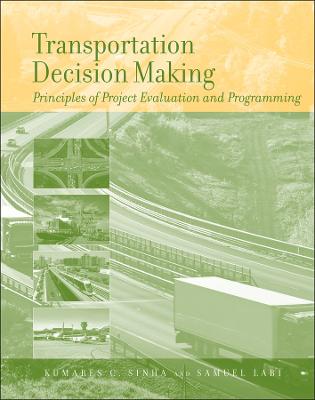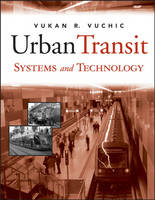Transportation Network Analysis
 -15%
portes grátis
-15%
portes grátis
Transportation Network Analysis
Iida, Yasunori; Bell, M. G. H.
John Wiley & Sons Inc
03/1997
232
Dura
Inglês
9780471964933
15 a 20 dias
488
Descrição não disponível.
Preface v
1 Introduction 1
1.1 Motivation and approach 1
1.2 Network representation 2
1.3 Modes of travel 3
1.4 Network equilibrium 3
1.5 Generalised costs 5
1.6 Demand curves 6
1.7 Link cost functions 6
1.8 Supply curves 10
1.9 lntermodal equilibrium 12
1.10 User benefit and surplus 14
1.11 Time dependency 15
1.12 Structure of the book 15
2 Transportation Networks 17
2.1 Introduction 17
2.2 Network terminology 17
2.3 Transportation network types 19
2.4 Flow and cost variables 21
2.5 Incidence matrices 22
2.6 Conservation relationships 24
2.7 Shortest path algorithms 25
2.8 Path enumeration and column generation 29
2.9 Link choice probabilities 29
2.10 Utility maximisation and expected minimum cost 33
2.11 Network capacity 34
2.12 Space-time networks 34
2.13 Network equilibrium 37
2.14 Concluding remarks 40
3 Optimality 41
3.1 Introduction 41
3.2 Kinds of variable 41
3.3 Matrix operations 42
3.4 Objective functions 45
3.5 Constraints 47
3.6 Optimality conditions 49
3.7 Dual variables 51
3.8 Lagrangian equation 54
3.9 Sensitivities 56
3.10 Method of successive averages 59
3.11 Iterative balancing 59
3.12 Summary 61
3.13 Notation 65
4 Cost Functions 67
4.1 Introduction 67
4.2 Traffic representation 67
4.3 Link costs 68
4.4 Junction costs 72
4.5 Priority junctions 78
4.6 Signal controlled junctions 78
4.7 Discussion 82
5 Deterministic User Equilibrium Assignment 83
5.1 Introduction 83
5.2 Existence and uniqueness 86
5.3 Solution algorithms 89
5.4 Sensitivity 95
5.5 Most likely path flows 100
5.6 Elastic demand 102
5.7 lime-dependent networks 108
5.8 Discussion 111
6 Stochastic User Equilibrium Assignment 113
6.1 Introduction 113
6.2 Existence and uniqueness 115
6.3 A general equivalent optimisation problem 118
6.4 Logit assignment 120
6.5 Probit assignment 133
6.6 Sensitivity 134
6.7 Elastic demand 138
6.8 Space-time networks 140
6.9 Discussion 148
7 Trip Table Estimation 149
7.1 Introduction 149
7.2 Maximum entropy 150
7.3 An generalised least squares 155
7.4 Bi-level programming 156
7.5 Linear path flow estimation 160
7.6 Log-linear path flow estimation 164
7.7 lime-dependent methods 170
7.8 Conclusions 176
8 Network Reliability 179
8.1 Introduction 179
8.2 Connectivity 179
8.3 Structure function 180
8.4 Structure function and reliability value 183
8.5 Exact methods 185
8.6 Heuristic methods 186
8.7 Travel time reliability 191
8.8 Future challenges 192
9 Network Design 193
9.1 Introduction 193
9.2 Objective function 195
9.3 Bi-Level programming 196
9.4 Sensitivities 197
9.5 Numerical example 199
9.6 Conclusions 204
10 Conclusions 205
10.1 Network equilibrium 205
10.2 Traffic assignment 206
10.3 Path flow estimation 207
10.4 Network reliability 208
10.5 Network design 208
References 209
Index 215
1 Introduction 1
1.1 Motivation and approach 1
1.2 Network representation 2
1.3 Modes of travel 3
1.4 Network equilibrium 3
1.5 Generalised costs 5
1.6 Demand curves 6
1.7 Link cost functions 6
1.8 Supply curves 10
1.9 lntermodal equilibrium 12
1.10 User benefit and surplus 14
1.11 Time dependency 15
1.12 Structure of the book 15
2 Transportation Networks 17
2.1 Introduction 17
2.2 Network terminology 17
2.3 Transportation network types 19
2.4 Flow and cost variables 21
2.5 Incidence matrices 22
2.6 Conservation relationships 24
2.7 Shortest path algorithms 25
2.8 Path enumeration and column generation 29
2.9 Link choice probabilities 29
2.10 Utility maximisation and expected minimum cost 33
2.11 Network capacity 34
2.12 Space-time networks 34
2.13 Network equilibrium 37
2.14 Concluding remarks 40
3 Optimality 41
3.1 Introduction 41
3.2 Kinds of variable 41
3.3 Matrix operations 42
3.4 Objective functions 45
3.5 Constraints 47
3.6 Optimality conditions 49
3.7 Dual variables 51
3.8 Lagrangian equation 54
3.9 Sensitivities 56
3.10 Method of successive averages 59
3.11 Iterative balancing 59
3.12 Summary 61
3.13 Notation 65
4 Cost Functions 67
4.1 Introduction 67
4.2 Traffic representation 67
4.3 Link costs 68
4.4 Junction costs 72
4.5 Priority junctions 78
4.6 Signal controlled junctions 78
4.7 Discussion 82
5 Deterministic User Equilibrium Assignment 83
5.1 Introduction 83
5.2 Existence and uniqueness 86
5.3 Solution algorithms 89
5.4 Sensitivity 95
5.5 Most likely path flows 100
5.6 Elastic demand 102
5.7 lime-dependent networks 108
5.8 Discussion 111
6 Stochastic User Equilibrium Assignment 113
6.1 Introduction 113
6.2 Existence and uniqueness 115
6.3 A general equivalent optimisation problem 118
6.4 Logit assignment 120
6.5 Probit assignment 133
6.6 Sensitivity 134
6.7 Elastic demand 138
6.8 Space-time networks 140
6.9 Discussion 148
7 Trip Table Estimation 149
7.1 Introduction 149
7.2 Maximum entropy 150
7.3 An generalised least squares 155
7.4 Bi-level programming 156
7.5 Linear path flow estimation 160
7.6 Log-linear path flow estimation 164
7.7 lime-dependent methods 170
7.8 Conclusions 176
8 Network Reliability 179
8.1 Introduction 179
8.2 Connectivity 179
8.3 Structure function 180
8.4 Structure function and reliability value 183
8.5 Exact methods 185
8.6 Heuristic methods 186
8.7 Travel time reliability 191
8.8 Future challenges 192
9 Network Design 193
9.1 Introduction 193
9.2 Objective function 195
9.3 Bi-Level programming 196
9.4 Sensitivities 197
9.5 Numerical example 199
9.6 Conclusions 204
10 Conclusions 205
10.1 Network equilibrium 205
10.2 Traffic assignment 206
10.3 Path flow estimation 207
10.4 Network reliability 208
10.5 Network design 208
References 209
Index 215
Este título pertence ao(s) assunto(s) indicados(s). Para ver outros títulos clique no assunto desejado.
fabric; societies; networks; kinds; various; water; spatial; transportation; concerned; network; temporal; movement; across; people; land; roads; rail; infrastructure; flows; framework; theoretical
Preface v
1 Introduction 1
1.1 Motivation and approach 1
1.2 Network representation 2
1.3 Modes of travel 3
1.4 Network equilibrium 3
1.5 Generalised costs 5
1.6 Demand curves 6
1.7 Link cost functions 6
1.8 Supply curves 10
1.9 lntermodal equilibrium 12
1.10 User benefit and surplus 14
1.11 Time dependency 15
1.12 Structure of the book 15
2 Transportation Networks 17
2.1 Introduction 17
2.2 Network terminology 17
2.3 Transportation network types 19
2.4 Flow and cost variables 21
2.5 Incidence matrices 22
2.6 Conservation relationships 24
2.7 Shortest path algorithms 25
2.8 Path enumeration and column generation 29
2.9 Link choice probabilities 29
2.10 Utility maximisation and expected minimum cost 33
2.11 Network capacity 34
2.12 Space-time networks 34
2.13 Network equilibrium 37
2.14 Concluding remarks 40
3 Optimality 41
3.1 Introduction 41
3.2 Kinds of variable 41
3.3 Matrix operations 42
3.4 Objective functions 45
3.5 Constraints 47
3.6 Optimality conditions 49
3.7 Dual variables 51
3.8 Lagrangian equation 54
3.9 Sensitivities 56
3.10 Method of successive averages 59
3.11 Iterative balancing 59
3.12 Summary 61
3.13 Notation 65
4 Cost Functions 67
4.1 Introduction 67
4.2 Traffic representation 67
4.3 Link costs 68
4.4 Junction costs 72
4.5 Priority junctions 78
4.6 Signal controlled junctions 78
4.7 Discussion 82
5 Deterministic User Equilibrium Assignment 83
5.1 Introduction 83
5.2 Existence and uniqueness 86
5.3 Solution algorithms 89
5.4 Sensitivity 95
5.5 Most likely path flows 100
5.6 Elastic demand 102
5.7 lime-dependent networks 108
5.8 Discussion 111
6 Stochastic User Equilibrium Assignment 113
6.1 Introduction 113
6.2 Existence and uniqueness 115
6.3 A general equivalent optimisation problem 118
6.4 Logit assignment 120
6.5 Probit assignment 133
6.6 Sensitivity 134
6.7 Elastic demand 138
6.8 Space-time networks 140
6.9 Discussion 148
7 Trip Table Estimation 149
7.1 Introduction 149
7.2 Maximum entropy 150
7.3 An generalised least squares 155
7.4 Bi-level programming 156
7.5 Linear path flow estimation 160
7.6 Log-linear path flow estimation 164
7.7 lime-dependent methods 170
7.8 Conclusions 176
8 Network Reliability 179
8.1 Introduction 179
8.2 Connectivity 179
8.3 Structure function 180
8.4 Structure function and reliability value 183
8.5 Exact methods 185
8.6 Heuristic methods 186
8.7 Travel time reliability 191
8.8 Future challenges 192
9 Network Design 193
9.1 Introduction 193
9.2 Objective function 195
9.3 Bi-Level programming 196
9.4 Sensitivities 197
9.5 Numerical example 199
9.6 Conclusions 204
10 Conclusions 205
10.1 Network equilibrium 205
10.2 Traffic assignment 206
10.3 Path flow estimation 207
10.4 Network reliability 208
10.5 Network design 208
References 209
Index 215
1 Introduction 1
1.1 Motivation and approach 1
1.2 Network representation 2
1.3 Modes of travel 3
1.4 Network equilibrium 3
1.5 Generalised costs 5
1.6 Demand curves 6
1.7 Link cost functions 6
1.8 Supply curves 10
1.9 lntermodal equilibrium 12
1.10 User benefit and surplus 14
1.11 Time dependency 15
1.12 Structure of the book 15
2 Transportation Networks 17
2.1 Introduction 17
2.2 Network terminology 17
2.3 Transportation network types 19
2.4 Flow and cost variables 21
2.5 Incidence matrices 22
2.6 Conservation relationships 24
2.7 Shortest path algorithms 25
2.8 Path enumeration and column generation 29
2.9 Link choice probabilities 29
2.10 Utility maximisation and expected minimum cost 33
2.11 Network capacity 34
2.12 Space-time networks 34
2.13 Network equilibrium 37
2.14 Concluding remarks 40
3 Optimality 41
3.1 Introduction 41
3.2 Kinds of variable 41
3.3 Matrix operations 42
3.4 Objective functions 45
3.5 Constraints 47
3.6 Optimality conditions 49
3.7 Dual variables 51
3.8 Lagrangian equation 54
3.9 Sensitivities 56
3.10 Method of successive averages 59
3.11 Iterative balancing 59
3.12 Summary 61
3.13 Notation 65
4 Cost Functions 67
4.1 Introduction 67
4.2 Traffic representation 67
4.3 Link costs 68
4.4 Junction costs 72
4.5 Priority junctions 78
4.6 Signal controlled junctions 78
4.7 Discussion 82
5 Deterministic User Equilibrium Assignment 83
5.1 Introduction 83
5.2 Existence and uniqueness 86
5.3 Solution algorithms 89
5.4 Sensitivity 95
5.5 Most likely path flows 100
5.6 Elastic demand 102
5.7 lime-dependent networks 108
5.8 Discussion 111
6 Stochastic User Equilibrium Assignment 113
6.1 Introduction 113
6.2 Existence and uniqueness 115
6.3 A general equivalent optimisation problem 118
6.4 Logit assignment 120
6.5 Probit assignment 133
6.6 Sensitivity 134
6.7 Elastic demand 138
6.8 Space-time networks 140
6.9 Discussion 148
7 Trip Table Estimation 149
7.1 Introduction 149
7.2 Maximum entropy 150
7.3 An generalised least squares 155
7.4 Bi-level programming 156
7.5 Linear path flow estimation 160
7.6 Log-linear path flow estimation 164
7.7 lime-dependent methods 170
7.8 Conclusions 176
8 Network Reliability 179
8.1 Introduction 179
8.2 Connectivity 179
8.3 Structure function 180
8.4 Structure function and reliability value 183
8.5 Exact methods 185
8.6 Heuristic methods 186
8.7 Travel time reliability 191
8.8 Future challenges 192
9 Network Design 193
9.1 Introduction 193
9.2 Objective function 195
9.3 Bi-Level programming 196
9.4 Sensitivities 197
9.5 Numerical example 199
9.6 Conclusions 204
10 Conclusions 205
10.1 Network equilibrium 205
10.2 Traffic assignment 206
10.3 Path flow estimation 207
10.4 Network reliability 208
10.5 Network design 208
References 209
Index 215
Este título pertence ao(s) assunto(s) indicados(s). Para ver outros títulos clique no assunto desejado.




